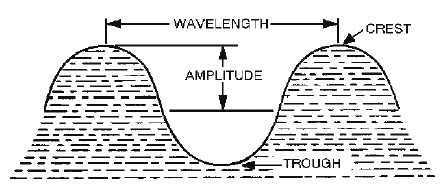1-5
TRANSVERSE WAVES
To explain transverse waves, we will again use our example of water waves. Figure 1-3 is a cross
section diagram of waves viewed from the side. Notice that the waves are a succession of crests and
troughs. The wavelength (one 360 degree cycle) is the distance from the crest of one wave to the crest of
the next, or between any two similar points on adjacent waves. The amplitude of a transverse wave is half
the distance measured vertically from the crest to the trough. Water waves are known as transverse waves
because the motion of the water is up and down, or at right angles to the direction in which the waves are
traveling. You can see this by observing a cork bobbing up and down on water as the waves pass by; the
cork moves very little in a sideways direction. In figure 1-4, the small arrows show the up-and-down
direction the cork moves as the transverse wave is set in motion. The direction the wave travels is shown
by the large arrow. Radio waves, light waves, and heat waves are examples of transverse waves.
Figure 1-3.—Elements of a wave.
Figure 1-4.—Transverse wave.
LONGITUDINAL WAVES
In the previous discussion, we listed radio waves, light waves, and heat waves as examples of
transverse waves, but we did not mention sound waves. Why? Simply because sound waves are
LONGITUDINAL WAVES. Unlike transverse waves, which travel at right angles to the direction of
propagation, sound waves travel back and forth in the same direction as the wave motion. Therefore,
longitudinal waves are waves in which the disturbance takes place in the direction of propagation.
Longitudinal waves are sometimes called COMPRESSION WAVES.
Waves that make up sound, such as those set up in the air by a vibrating tuning fork, are longitudinal
waves. In figure 1-5, the tuning fork, when struck, sets up vibrations. As the tine moves in an outward
direction, the air immediately in front of it is compressed (made more dense) so that its momentary



